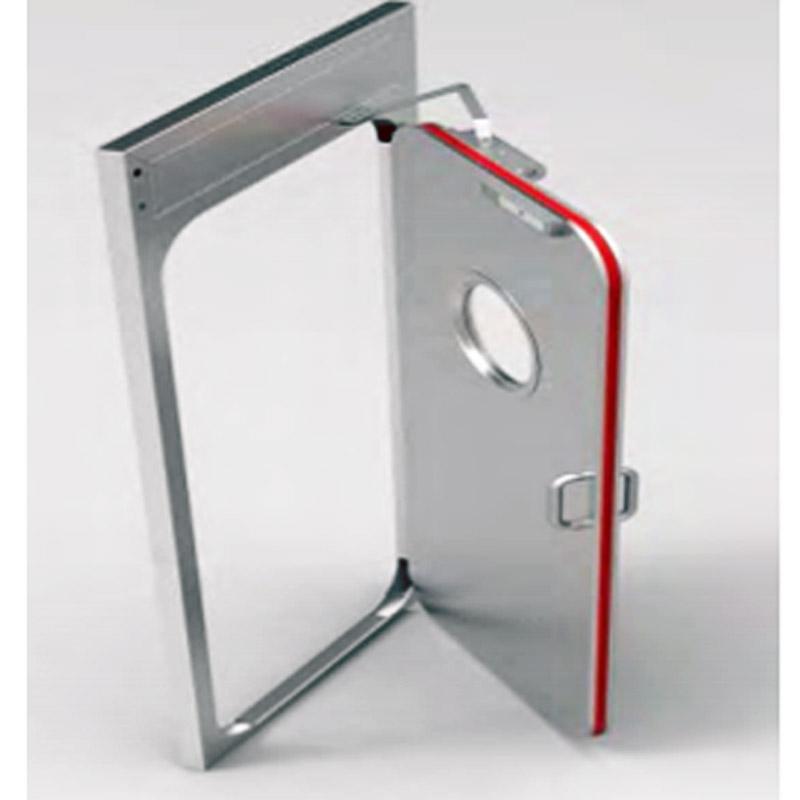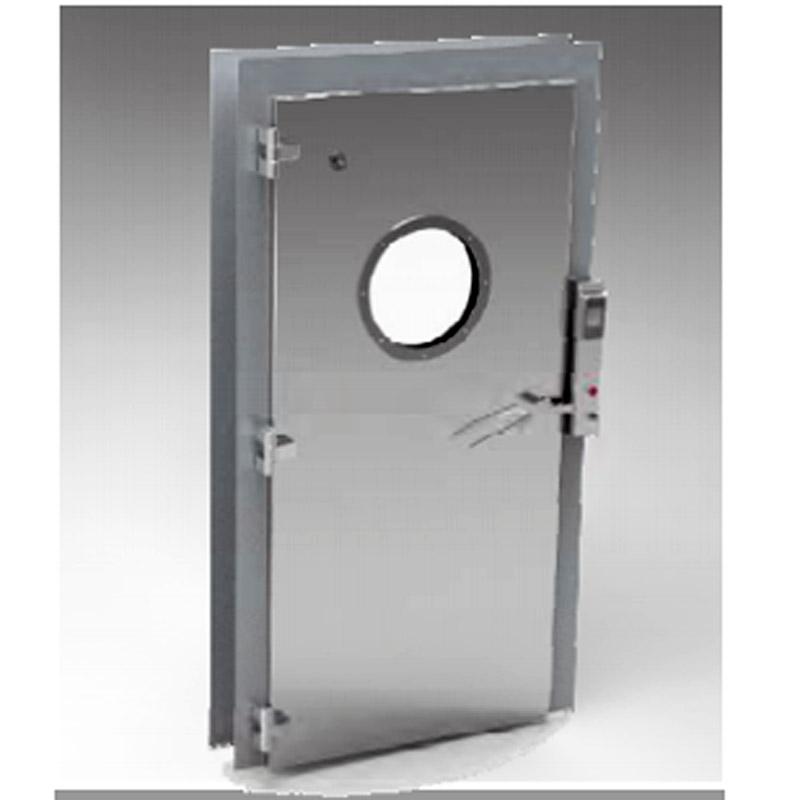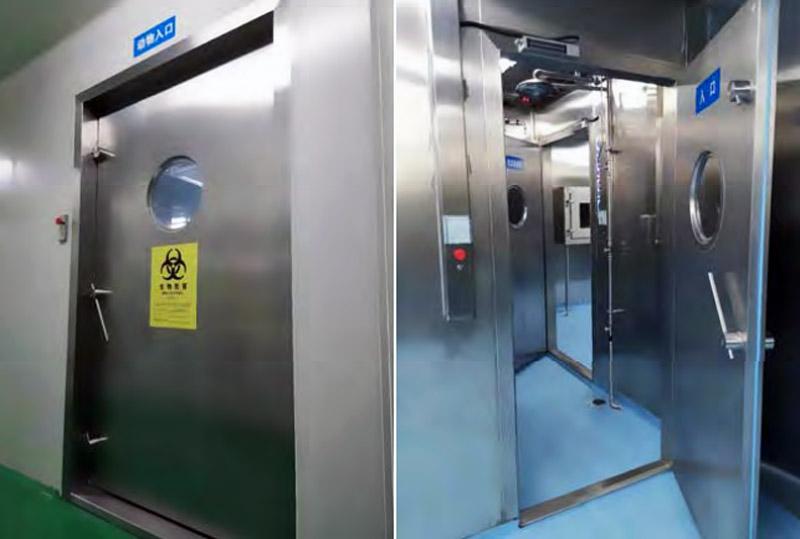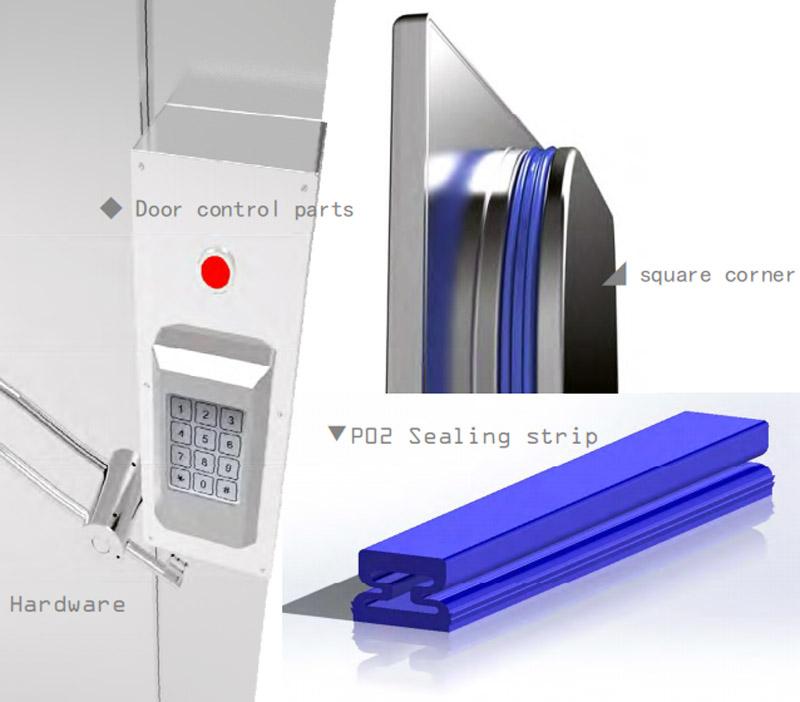How many types of Biosafety airtight doors are for the cleanroom?
There are two primary types of biological safety airtight doors: mechanical compression airtight doors and inflatable airtight doors.
Inflatable airtight doors
The inflatable airtight door consists of key components such as a door frame, door panel, inflatable sealing strip, and a control system. The inflatable sealing strip is specifically installed within the groove surrounding the door.
When the door is opened, the inflatable sealing strip retracts or shrinks within the groove. This allows for unobstructed passage and easy access through the door.
When the door is closed, the inflatable sealing strip automatically inflates to its designated size. This inflation process creates a tight seal between the door and the door frame, ensuring an airtight barrier. Simultaneously, the door securely locks into place, providing additional security and stability.
The inflatable sealing strip plays a vital role in achieving an effective seal. When the door is closed, it expands and fills the space between the door panel and the door frame, creating a secure and tight barrier against air leakage and the intrusion of contaminants.
The control system of the inflatable airtight door manages the inflation and deflation of the sealing strip. It ensures the precise timing and control of the inflation process, allowing for a reliable and consistent seal each time the door is closed.
The mechanical compression airtight door
The mechanical compression airtight door consists of essential components such as a door frame, door body, sealing strip, mechanical compression mechanism, and control device. The sealing strip is specifically installed on the door frame, ensuring a precise fit.
When the mechanical compression airtight door is closed, the sealing strip is tightly pressed against the edge of the door frame. This mechanism creates a secure and strict seal between the door and the door frame, preventing any potential leakage or infiltration of air or contaminants.
The door frame provides structural support and serves as the framework for the door assembly. It ensures stability and proper alignment during the opening and closing of the door.
The door body, which is attached to the door frame, forms the physical barrier of the airtight door. It is designed to be sturdy and durable, capable of withstanding pressure differentials and maintaining the integrity of the controlled environment.
The sealing strip plays a crucial role in achieving a tight seal. It is strategically positioned on the door frame and functions as a barrier against air leakage. When the door is closed, the sealing strip is compressed against the door frame, creating an airtight seal that prevents the escape or entry of air and contaminants.
The mechanical compression mechanism is responsible for applying pressure to the sealing strip. It ensures a consistent and uniform compression force along the door frame, maintaining a reliable and secure seal.
Lastly, the control device enables the smooth operation and control of the mechanical compression airtight door. It allows for manual or automated control, ensuring precise alignment, proper compression, and reliable sealing.
Both types of biological safety airtight doors are critical components of the laboratory enclosure structure, as they contribute to maintaining the required airtightness and integrity of the biosafety laboratory. They play a significant role in ensuring the reliability and effectiveness of the laboratory’s biological safety measures.


How do Biosafety airtight doors for the cleanroom works?
It consists of essential components such as a door frame, door panel, inflatable sealing strip, and a control system. The inflatable sealing strip is specifically installed within a groove on the side of the door leaf.
The working principle of the inflatable airtight door is as follows: when the door is opened, the inflatable sealing strip retracts within the groove, allowing for unobstructed passage. However, when the door is closed, the sealing strip is automatically inflated. This inflation process creates a tight seal between the door and the door frame, ensuring a secure and airtight closure. Simultaneously, the door is securely locked into place.
The use of the inflatable sealing strip in the design of this type of airtight door enables efficient sealing and enhanced security. When the door is closed, the inflation of the sealing strip provides a reliable barrier against the exchange of air, contaminants, and other external elements. This mechanism helps to maintain the integrity of the controlled environment and ensures optimal conditions within the space.
The inflatable airtight door’s ability to automatically inflate and deflate the sealing strip during the opening and closing process adds convenience and ease of use. It streamlines the door operation and ensures a consistent and effective seal each time the door is closed.
Overall, the inflatable airtight door’s key features, including the door frame, door panel, inflatable sealing strip, and control system, work in harmony to create a secure and airtight closure. Its operational principle of inflation and deflation of the sealing strip enables reliable sealing, contributing to the maintenance of a controlled and protected environment.

The inflatable airtight door encompasses several key features that contribute to its functionality.
Fully sealed structure design – The design of the fully sealed structure ensures a comprehensive and effective barrier against external elements. It prevents the ingress of contaminants and maintains the integrity of the enclosed space.
Sealing pressure monitoring – The sealing pressure monitoring feature continuously monitors and regulates the pressure exerted on the door seal. This ensures optimal sealing performance and identifies any deviations that may compromise the airtightness.
Supply gas pressure monitoring – Supply gas pressure monitoring ensures that the gas used to inflate the sealing strip is maintained at the appropriate level. It allows for real-time monitoring and adjustments to ensure consistent and reliable inflation, contributing to a tight and secure seal.
Automatic airtight door hinge – The automatic airtight door hinge facilitates smooth and efficient door operation. It enables automatic closing and locking of the door, eliminating the need for manual intervention and ensuring a reliable seal.
Independent PLC control – The independent PLC control system provides centralized control and management of the airtight door’s operations. It allows for seamless integration with other systems and enables customized programming to meet specific requirements.
Configurable buttons and LED indicators – Configurable buttons and LED indicators offer user-friendly control and status indication. They can be programmed and personalized based on individual needs, providing intuitive operation and clear visual feedback.
Visual windows can be installed – Visual windows can be installed in the airtight door, offering transparency and visibility into the adjoining areas. This allows for visual monitoring of the space without compromising the overall airtightness of the door.

YOUTH’s Customized Options – Inflatable Airtight Doors:
Optional Interlocking System: YOUTH provides the option for an interlocking system, allowing for enhanced security and controlled access. This feature ensures that only one door can be open at a time, preventing air leakage and maintaining the integrity of the cleanroom environment.
Versatile Door Frame Compatibility: The door frame offered by YOUTH is designed to seamlessly match all forms of wall panels. This compatibility ensures a seamless and cohesive integration between the airtight door and the surrounding cleanroom structure.
Discreet Wall Mounting Accessories: YOUTH’s airtight doors are designed with a focus on aesthetics and cleanliness. Therefore, visual mounting accessories on the wall are eliminated, resulting in a sleek and clean appearance that maintains the integrity of the cleanroom environment.
Optional Dual Seal: YOUTH offers the option for a dual seal mechanism in their airtight doors. This additional sealing layer enhances the door’s airtightness, providing an extra level of protection against contamination and maintaining strict cleanroom requirements.
Continuous Gas Supply during Power Loss: YOUTH’s airtight doors can be configured to supply gas continuously, even during power outages. This feature ensures the uninterrupted inflation of the sealing strip, maintaining the door’s airtight seal and preventing any compromise in cleanroom integrity.
Configurable Vent Valve: YOUTH’s airtight doors can be equipped with a vent valve, allowing for controlled airflow and pressure regulation within the cleanroom. This feature provides flexibility in managing air exchange rates and adjusting pressure differentials according to specific cleanroom requirements.
Electric Door Closer: YOUTH offers electric door closers as an option for their airtight doors. This feature ensures reliable and automatic closing of the door, enhancing convenience and maintaining the integrity of the airtight seal.
Covered Visual Window: YOUTH provides the option to cover the visual window in their airtight doors. This allows for privacy or specific light control requirements while still maintaining the overall airtightness and cleanliness of the door.
Independent PLC Control: YOUTH’s airtight doors feature an independent PLC control system. This allows for centralized and customizable control of door operations, integration with cleanroom management systems, and the ability to monitor and manage various parameters for optimal performance.
Customizable Maximum Dimensions: YOUTH can design airtight doors with maximum dimensions of up to 4 meters in length and 2.5 meters in width. This flexibility enables the doors to accommodate larger openings while maintaining their airtightness and structural integrity.
YOUTH’s range of customized options ensures that their airtight doors can be tailored to meet specific cleanroom requirements, providing enhanced functionality, flexibility, and performance in maintaining the desired level of cleanliness and containment.
YOUTH’s Customized Options – The mechanical compression airtight door:
Optional Interlocking System: YOUTH offers the option to include an interlocking system for their airtight doors. This feature provides enhanced security and controlled access by ensuring that only one door can be open at a time, minimizing air leakage and maintaining the integrity of the cleanroom environment.
Versatile Door Frame Compatibility: YOUTH’s airtight doors are designed to seamlessly match all forms of wall panels. This compatibility ensures seamless integration between the door frame and the surrounding cleanroom structure, creating a cohesive and aesthetically pleasing appearance.
Discreet Wall Mounting Accessories: YOUTH’s attention to detail extends to the cleanroom environment. Their airtight doors are designed without visible mounting accessories on the wall, creating a clean and sleek appearance while maintaining the cleanliness and integrity of the cleanroom environment.
Electric Door Closer: YOUTH offers the option of an electric door closer for their airtight doors. This feature ensures reliable and automated closing of the door, adding convenience and further maintaining the integrity of the airtight seal.
Covered Visual Window: YOUTH provides the option to cover the visual window in its airtight doors. This allows for privacy or specific light control requirements while still maintaining the overall airtightness and cleanliness of the door.
SS304 or SS316L Options: YOUTH offers the choice of using SS304 or SS316L stainless steel for their airtight doors. These high-quality stainless steel options provide durability, corrosion resistance, and compatibility with cleanroom environments, meeting the specific requirements of different industries and applications.
Customizable Maximum Dimensions: YOUTH can design airtight doors with maximum dimensions of up to 4 meters in length and 2.5 meters in width. This flexibility allows for the accommodation of larger openings while ensuring the airtightness and structural integrity necessary for cleanroom environments.
what are the Pneumatic Seal APR Doors?
Pneumatic Seal APR Doors, or Pneumatic Seal Air Pressure Release Doors, are specialized doors designed to provide a high level of airtight containment in environments where maintaining air quality, preventing contamination, or controlling pressure differentials is critical. These doors are equipped with pneumatic (air pressure) sealing mechanisms to ensure a secure seal when the door is closed.
Airtight Containment: Pneumatic Seal APR Doors are engineered to offer the highest possible level of airtight containment. This is particularly important in applications where maintaining specific environmental conditions, such as cleanrooms, bio-hazard laboratories, and pharmaceutical facilities, is essential.
Pneumatic Sealing Mechanism: These doors utilize compressed air to create a tight seal around the door’s perimeter. When the door is closed, the pneumatic sealing system inflates, pressing the door tightly against a doorframe and creating an effective barrier against air leakage.
Pressure Differential Resistance: Pneumatic Seal APR Doors are designed to resist pressure differences. They can maintain their seal even when there are significant pressure variations on either side of the door, making them suitable for high-pressure cleanroom environments.
Medical-Grade Compressed Air: Many Pneumatic Seal APR Doors can be operated using existing medical-grade compressed air systems, providing a reliable and readily available power source.
Material Options: These doors are available in various materials, including polished stainless steel, powder-coated low carbon steel, aluminum, and phenolic resin. The choice of material depends on the specific requirements and environmental conditions of the application.
Applications: Pneumatic Seal APR Doors are commonly used in high-containment and high-traffic situations where air leakage cannot be tolerated. Examples of applications include bio-hazard laboratories (BSL3, BSL4, BSL3-Ag, and BSL4-Ag), pharmaceutical laboratories, medical clean rooms, and any environment where maintaining a sterile or controlled atmosphere is crucial.
Overall, Pneumatic Seal APR Doors play a crucial role in ensuring the integrity of controlled environments by preventing the escape of contaminants and maintaining the desired conditions within a given space.
FAQs
What is an Airtight Door?
- An airtight door is a specialized door designed to create a secure seal, preventing the passage of air and contaminants between two spaces.
What is a Pneumatic Seal APR Door?
- A Pneumatic Seal APR Door is a type of airtight door that uses compressed air to achieve a tight seal, commonly used in high-containment environments.
Where are Airtight Doors typically used?
- Airtight doors find application in environments like cleanrooms, laboratories, pharmaceutical facilities, and places where maintaining specific conditions is crucial.
How does a Pneumatic Seal APR Door work?
- Pneumatic Seal APR Doors work by inflating a sealing mechanism with compressed air when the door is closed, creating an airtight seal.
What materials are Airtight Doors made of?
- Airtight doors can be constructed from materials like stainless steel, low carbon steel, aluminum, or phenolic resin, depending on the application’s requirements.
Can Airtight Doors withstand pressure differences?
- Yes, many Airtight Doors, including Pneumatic Seal APR Doors, are designed to resist pressure differences and maintain their seal in high-pressure environments.
What are the benefits of using Airtight Doors?
- Airtight doors help maintain controlled environments, prevent contamination, and ensure air quality, making them essential in critical applications.
Are Airtight Doors easy to operate?
- Airtight doors are typically designed for ease of operation, with some models featuring automated controls for user convenience.
Can existing compressed air systems be used with Pneumatic Seal APR Doors?
- Yes, many Pneumatic Seal APR Doors can be operated using existing medical-grade compressed air systems.
Are Airtight Doors customizable to fit specific requirements?
- Yes, Airtight Doors can often be customized to meet specific size, material, and operational requirements, making them adaptable to various applications.
Related Contents:
- Bag-In/Bag-Out (BIBO) Systems: Operation and Maintenance Guide
- Ensuring Sterility in Cleanrooms: The Crucial Role of YOUTH Biosafety Airtight Doors
- Ensuring Sterility: The Role of YOUTH Biosafety Airtight Doors in Cleanrooms
- How to Choose the Right Cleanroom Door
- What are Gel Seal Mini-Pleat HEPA Filters and How to Make the Right Choice?
- The Cleanroom Experience: A Guide to Safe and Efficient Operations
- Fan Filter Units for Semiconductor Cleanrooms: A Must-Have Solution
- Fan Filter Units: A Comprehensive Solution for Cleanroom Air Purification
- Fan Filter Units: Key to Quality Control in Cleanroom Manufacturing Processes

























